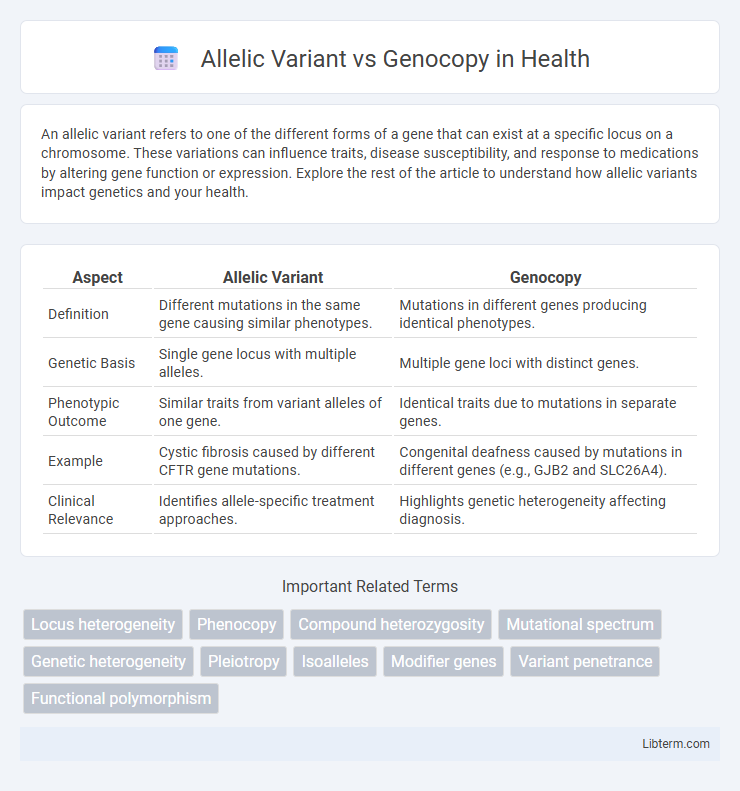An allelic variant refers to one of the different forms of a gene that can exist at a specific locus on a chromosome. These variations can influence traits, disease susceptibility, and response to medications by altering gene function or expression. Explore the rest of the article to understand how allelic variants impact genetics and your health.
Table of Comparison
| Aspect | Allelic Variant | Genocopy |
|---|---|---|
| Definition | Different mutations in the same gene causing similar phenotypes. | Mutations in different genes producing identical phenotypes. |
| Genetic Basis | Single gene locus with multiple alleles. | Multiple gene loci with distinct genes. |
| Phenotypic Outcome | Similar traits from variant alleles of one gene. | Identical traits due to mutations in separate genes. |
| Example | Cystic fibrosis caused by different CFTR gene mutations. | Congenital deafness caused by mutations in different genes (e.g., GJB2 and SLC26A4). |
| Clinical Relevance | Identifies allele-specific treatment approaches. | Highlights genetic heterogeneity affecting diagnosis. |
Introduction to Allelic Variant and Genocopy
An allelic variant refers to alternative forms of a gene occurring at the same locus on a chromosome, resulting in genetic diversity within a population. Genocopy describes a phenotype produced by different genetic mutations in separate genes that mimic the expression of a particular genotype, emphasizing genetic heterogeneity. Both concepts are key to understanding variation in genetic traits and disease mechanisms across individuals.
Genetic Terminology: Defining Allelic Variant
An allelic variant refers to different forms of the same gene present at a specific locus, contributing to genetic diversity within a population. This contrasts with a genocopy, where different genes produce similar phenotypic effects, highlighting the distinction between variations within a single gene versus similar traits arising from separate genetic origins. Understanding allelic variants is crucial for genetic analysis, disease association studies, and personalized medicine.
Understanding Genocopy: Concept and Context
Genocopy refers to a genetic variant that mimics the phenotypic effect of another allele but arises from a different gene or mutation, highlighting the complexity of genotype-phenotype relationships. Unlike allelic variants, which are different versions of the same gene, genocopies demonstrate how distinct genetic mechanisms can produce similar traits or diseases. Studying genocopies provides crucial insight into genetic heterogeneity and aids in accurate diagnosis and therapeutic strategies in medical genetics.
Molecular Mechanisms Behind Allelic Variants
Allelic variants arise from mutations such as single nucleotide polymorphisms (SNPs), insertions, deletions, or copy number variations within the same gene locus, altering the gene's coding sequence or regulatory elements. These molecular changes can affect protein function, expression levels, or splicing patterns, contributing to phenotypic diversity or disease susceptibility. In contrast, genocopies produce similar phenotypes through mutations in different genes, highlighting distinct molecular pathways underlying comparable traits.
How Genocopies Arise: Genetic and Environmental Influences
Genocopies arise when environmental factors mimic the phenotypic effects of specific genetic allelic variants, leading to similar traits without corresponding genetic mutations. These phenocopies result from complex interactions between non-genetic environmental influences, such as toxins or infections, and the organism's biological pathways. Unlike allelic variants, which are inherited mutations within DNA sequences, genocopies highlight the role of external conditions inducing phenotypes resembling genetic disorders.
Clinical Implications: Diagnosis and Misdiagnosis
Allelic variants involve different mutations within the same gene that can cause varying clinical phenotypes, influencing precise genetic diagnosis and personalized treatment strategies. Genocopies produce similar clinical presentations despite originating from mutations in distinct genes, complicating differential diagnosis and increasing the risk of misdiagnosis. Accurate identification of allelic variants versus genocopies through advanced genetic testing and molecular diagnostics is critical to avoid misdiagnosis and to guide effective clinical management.
Allelic Variant vs Genocopy: Key Differences
Allelic variants refer to different forms of a gene at the same locus, causing variations in the genetic sequence that may influence phenotypic traits or disease susceptibility. Genocopies involve distinct genetic mutations in different loci that produce similar phenotypic outcomes, mimicking the effect of a specific allelic variant. The key difference lies in allelic variants being alternative versions of the same gene, whereas genocopies represent different genes causing the same phenotype through convergent genetic pathways.
Case Studies: Real-World Examples
Case studies reveal allelic variants such as the BRCA1 mutation linked to hereditary breast cancer, demonstrating how specific genetic differences impact disease risk. In contrast, genocopies like phenylketonuria (PKU) showcase identical phenotypes caused by mutations in different genes, highlighting genetic heterogeneity. These real-world examples emphasize the critical role of precise genetic analysis in personalized medicine and diagnosis.
Advances in Genetic Testing and Identification
Advances in genetic testing technologies, such as next-generation sequencing and CRISPR-based methods, have significantly improved the ability to distinguish allelic variants from genocopies by enabling precise detection of specific nucleotide changes and gene function alterations. Allelic variants represent different forms of a gene at a particular locus, often associated with phenotypic variability, while genocopies involve distinct genetic mutations in different loci producing similar clinical phenotypes, challenging accurate diagnosis without high-resolution genomic tools. Enhanced bioinformatics algorithms and comprehensive variant databases facilitate the interpretation of complex genetic data, improving differentiation between allelic variants and genocopies for personalized medicine and targeted therapies.
Summary and Future Directions
Allelic variants represent different forms of a gene at the same locus, influencing phenotypic diversity and disease susceptibility, whereas genocopies refer to distinct genetic alterations causing similar phenotypes. Advancements in genomic technologies and bioinformatics are enhancing the identification and characterization of these genetic variations, enabling improved precision medicine strategies. Future research aims to integrate multi-omics data and functional assays to elucidate complex genotype-phenotype relationships, advancing targeted therapies and personalized interventions.
Allelic Variant Infographic

 libterm.com
libterm.com